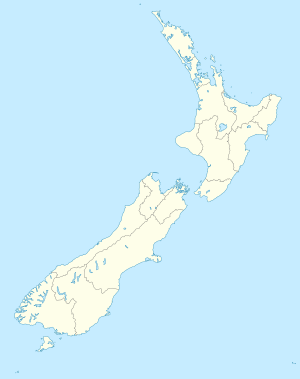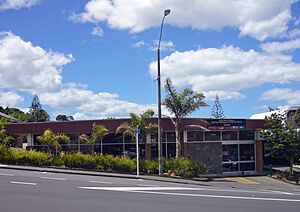Glenfield, New Zealand facts for kids
Quick facts for kids
Glenfield
|
|
|---|---|
|
Suburb
|
|
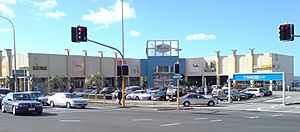
The front top parking lot at Glenfield Mall. Most of the parking, and most of the mall itself, is behind and below on further levels. (Photo taken prior to overhaul in the mid-2010s)
|
|
| Country | New Zealand |
| Local authority | Auckland |
| Electoral ward | North Shore Ward |
| Local board | Kaipātiki Local Board |
| Area | |
| • Land | 472 ha (1,166 acre) |
| Population
(June 2023)
|
|
| • Total | 17,630 |
| Postcode(s) |
0629
|
|
|
||
Glenfield (Māori: Te Wairau) is a suburb of Auckland, New Zealand, located on the North Shore. Established as a rural community in the 1850s, the area developed as a suburban part of Auckland after the completion of the Auckland Harbour Bridge in 1959.
Contents
Etymology
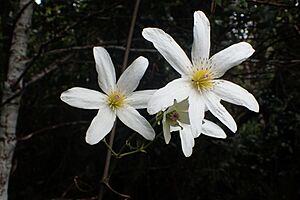
The name Mayfield was first associated with the area in the late 19th century. Before this, settlers considered the area rural sections of Takapuna, Birkenhead or Northcote. The name was first used in an advertisement by R. Arthur, a landowner who subdivided 250 acres of land in 1883. The name was adopted by residents for the school and area in 1890, referring to the blossoming white mānuka bushes that residents felt were reminiscent of springtime (i.e. May) in England. In 1912, local residents petitioned the post office to change the name of the area to Glenfield. Until this point, the post office used the name Freemans, referring to John Freeman, the homeowner who operated the post office from his home from 1888. The post office had refused to use the name Mayfield, due to potential confusion with Mayfield in the Canterbury Region.
The first name on early colonial maps associated with the area is Opuawananga, which refers to puawānanga, a native species of clematis. The name was used to refer to an inland bush area of the North Shore where puawānanga grew, which early European settlers called Quick's Bush. In 2013, Glenfield College adopted the name Te Puawānanga for the school's whare wānanga.
Geography
Glenfield is a suburb of the North Shore of New Zealand. It is located between the Kaipātiki Creek, a tributary of Oruamo or Hellyers Creek, and the Wairau Valley. The highest point in the suburb is a hill between Colin Wild Place and Chivalry Road, which reaches a height of 83 metres (272 ft) above sea level.
The area is primarily formed from Early Miocene Waitemata Group sandstone and mudstone. Prior to human settlement, the area was a kauri and mixed podocarp forest, which by the 19th century developed into a mānuka-dominated scrubland.
Areas within Glenfield include Marlborough, an area of south-eastern Glenfield that developed in the 1960s and early 1970s on the site of Alex Anderson's former farm, and Glenfield North.
History
Māori history
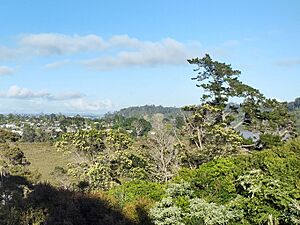
Māori settlement of the Auckland Region began around the 13th or 14th centuries. The North Shore was settled by Tāmaki Māori, including people descended from the Tainui migratory canoe and ancestors of figures such as Taikehu and Peretū. Many of the early Tāmaki Māori people of the North Shore identified as Ngā Oho,
The poor clay soils of the area were not suitable for Māori traditional gardening techniques, meaning Glenfield was not as densely settled as other areas of the North Shore, such as the Upper Waitematā Harbour eastern shores or the Devonport-Takapuna areas. The forests of the inland North Shore were a place where berries were harvested.
Archaeological middens have been found on the shores of the Kaipātiki Creek, and Manuka Road was originally an ara (traditional path) linking Oruamo or Hellyers Creek to the central North Shore.
The warrior Maki migrated from the Kāwhia Harbour to his ancestral home in the Auckland Region, likely sometime in the 17th century. Maki conquered and unified many the Tāmaki Māori tribes as Te Kawerau ā Maki, including those of the North Shore. After Maki's death, his sons settled different areas of his lands, creating new hapū. His younger son Maraeariki settled the North Shore and Hibiscus Coast, who based himself at the head of the Ōrewa River. Maraeariki's daughter Kahu succeeded him, and she is the namesake of the North Shore, Te Whenua Roa o Kahu ("The Greater Lands of Kahu"), Many of the iwi of the North Shore, including Ngāti Manuhiri, Ngāti Maraeariki, Ngāti Kahu, Ngāti Poataniwha, Ngāi Tai ki Tāmaki and Ngāti Whātua, can trace their lineage to Kahu.
During the early 1820s, most Māori of the North Shore fled for the Waikato or Northland due to the threat of war parties during the Musket Wars. When Tāmaki Māori returned in greater numbers to the Auckland Region in the mid-1830s, Te Kawerau ā Maki focused settlement at Te Henga / Bethells Beach.
Early European settlement
One of the earliest land sales to European settlers in Auckland took place near Glenfield on 17 April 1837, when Ngāti Whātua rangatira Nanihi and Tuire sold Te Pukapuka, a 320 acres (130 ha) block to American whaler William Webster, at the north-eastern headwaters of Oruamo or Hellyers Creek, near Bayview. Webster on-sold the land to Thomas Hellyer on 13 October 1840, who established the Retreat, a house which included a kauri sawpit, a hut, and a workshop. The Retreat became well known among sailors, who would stop at the Retreat for fresh water and beer from the Retreat's brewhouse. On 22 December 1841, Hellyer's body was discovered at the Retreat, and while an investigation took place, no person was convicted of his murder.
Glenfield was a part of the Mahurangi Block, which was purchased by the New Zealand Government in 1841. In the 1850s, the first European settlers in Glenfield developed orchards and dairy farms, including the Mackay and McFetridge families. The surrounding areas were worked by gum diggers, from 1859 up until the 1920s. Gum diggers would regularly set fire to the mānuka scrubland, in order to more easily locate kauri gum.
Windy Ridge was one of the first areas of inland Glenfield by European settlers, when Terence and Elizabeth Crook purchased 569 acres (230 ha) north of Coronation Road, known as Gooches Corner. The section was later farmed by Minnie Gracie and her husband Arthur Moore Gracie.
Rural community
In the latter 19th and early 20th centuries, the main connection to the outside world were bush tracks. Fruit and farm produce would be carried along tracks and horse carriages to Northcote and Birkenhead, then on to Auckland markets by ferry.
Glenfield developed as a rural community centred on Mayfield Road in the 1880s, developing after major improvements were made to the road at Aranui Bluff / Cut Hill in 1885. By 1889, 24 cottages were built in the area surrounding Cut Hill, and a kauri gum store was established at the junction of Sunset and Glenfield roads in the 1890s. By this time, the name Mayfield had become associated with the area. Dairy farms located in rural Glenfield supplied milk to Auckland, and the farms north of Glenfield specialised in supplying cream.
In 1888, the first post office was established at Glenfield, named Freemans after John Freeman's residence on the corner of Kaipatiki Road. In 1890, the New Zealand Hydropathic and Fruit Hospital was established at Glenfield, as a facility that treated conditions such as rheumatic gout, hysteria, dropsy, diabetes and constipation through treatments such as vegan diets and therapeutic baths.
In 1891, Mayfield School was opened, becoming a social centre for the growing area. Events such as card nights and concerts were held at the school in the 1900s, and residents complained of events where alcohol was consumed, which often left the school in a poor state, and was seen as causing rowdy behaviour and mayhem in the community. In 1912, the area was officially renamed Glenfield, due to issues the post office had with the name Mayfield being confused with Mayfield in the Canterbury Region.
On 4 September 1915, the local community constructed Mission Hall in a single day. The hall was a shared religious space used by local Anglican, Methodist and Presbyterian communities. By the 1920s, the first store was established on Glenfield Road, as well as two brickworks, which closed in the 1930s. By the late 1920s motorcars were becoming more popular than horses for transportation in Glenfield.
In the 1920s, local resident James Mackay discovered the Captain Cook strawberry variety at his land at Cooks Beach. The variety was smaller and sweeter than previously popular varieties, and from 1929 Glenfield growers invested in this strawberry crop. The Captain Cook strawberry became the most popular strawberry variety in the Auckland Region for the next few decades.
The Glenfield War Memorial Hall, first called for in the 1900s as a substitute for the school hall, was finally built in 1934. The hall hosted major social events, including elaborate coronation balls.
Suburbanisation
The opening of the Auckland Harbour Bridge in 1959 led to rapid suburbanisation of Glenfield. After Glenfield was declared a county town in 1961, the population grew from 5,683 to 13,335 in 1966. Most of the suburb was developed in the 1960s, with the western areas of Glenfield developing into suburban housing later on.
With a rapidly increasingly population, the Waitemata County Council decided to establish a rubbish dump on reclaimed land in the Oruamo or Hellyers Creek foreshore in 1969. The plans were widely protested by residents, and were scarpered after the New Zealand Airforce, who insisted that no landfills could be located within one nautical mile of the RNZAF Base at Whenuapai or the RNZAF Station Hobsonville.
Glenfield was one of the most rapidly developing areas of New Zealand in the early 1970s. On 9 December 1971, in response to fears about commercial sprawl down the length of Glenfield Road, Glenfield Mall opened. It was the first shopping mall on the North Shore. The Glenfield Library was constructed in 1975.
In 2000, Glenfield Mall was redeveloped as a more modern shopping centre.
Notable people
- James K. Baxter, author and poet. While not a resident, Baxter died in Glenfield in October 1972.
- Janet Frame, author who lived in Glenfield in the 1970s
- Rachel Hunter, model who was raised in Glenfield
Amenities
- Southern Cross Hospital North Harbour, a privately owned hospital, is in Wairau Road.
- Agincourt Reserve, home to the Marlborough Kindergarten and North Shore Woodturners Guild, established in 1984.
- Marlborough Park, a suburban park which features playgrounds, the Marlborough Park Tennis Club, and the Marlborough Park Skate Park, which opened in 2020. It the home of Kaipātiki Community Trust and Marlborough Park Hall.
Education
Glenfield College, founded in 1969, is a secondary (years 9–13) school with a roll of 656 students. Glenfield Intermediate, founded in 1972, is an intermediate (years 7–8) school with 396 students. Glenfield Primary School, founded in 1959, is a contributing primary (years 1–6) school with a roll of 254. Marlborough Primary School is a coeducational contributing primary (years 1–6) school with a decile rating of 7 and a roll of 274, and Windy Ridge School is a coeducational contributing primary school (years 1–6), with a decile rating of 7 and a roll of 198, which includes two satellite classes from Wilson School for students with intellectual or physical disabilities. All schools are coeducational. Rolls are as of February 2024.
The South Seas Film, Television, and Animation school is in Glenfield.
Sport
Glenfield is home to Glenfield RFC, who are a member of the North Harbour Rugby Union, and Glenfield Rovers, who compete in the Lotto Sport Italia NRFL Division 1B. The Glenfield Greyhounds rugby league club are based in nearby Sunnynook.
Demographics
Glenfield covers 4.72 km2 (1.82 sq mi) and had an estimated population of 17630 as of June 2023, with a population density of 3,735 inhabitants per square kilometre (9,670/sq mi).
| Historical population | ||
|---|---|---|
| Year | Pop. | ±% p.a. |
| 2006 | 14,370 | — |
| 2013 | 15,414 | +1.01% |
| 2018 | 16,872 | +1.82% |
Glenfield had a population of 16,872 at the 2018 New Zealand census, an increase of 1,458 people (9.5%) since the 2013 census, and an increase of 2,502 people (17.4%) since the 2006 census. There were 5,286 households, comprising 8,397 males and 8,472 females, giving a sex ratio of 0.99 males per female, with 2,913 people (17.3%) aged under 15 years, 4,245 (25.2%) aged 15 to 29, 7,896 (46.8%) aged 30 to 64, and 1,821 (10.8%) aged 65 or older.
Ethnicities were 43.3% European/Pākehā, 6.9% Māori, 4.7% Pasifika, 48.9% Asian, and 4.8% other ethnicities. People may identify with more than one ethnicity.
The percentage of people born overseas was 55.0, compared with 27.1% nationally.
Although some people chose not to answer the census's question about religious affiliation, 43.0% had no religion, 39.5% were Christian, 0.3% had Māori religious beliefs, 4.9% were Hindu, 2.3% were Muslim, 2.9% were Buddhist and 2.3% had other religions.
Of those at least 15 years old, 4,509 (32.3%) people had a bachelor's or higher degree, and 1,551 (11.1%) people had no formal qualifications. 2,052 people (14.7%) earned over $70,000 compared to 17.2% nationally. The employment status of those at least 15 was that 7,503 (53.8%) people were employed full-time, 1,941 (13.9%) were part-time, and 507 (3.6%) were unemployed.
| Name | Area (km2) |
Population | Density (per km2) |
Households | Median age | Median income |
|---|---|---|---|---|---|---|
| Glenfield North | 0.81 | 3,333 | 4,115 | 1,029 | 32.7 years | $34,100 |
| Glenfield West | 0.97 | 3,084 | 3,179 | 1,026 | 35.0 years | $31,000 |
| Glenfield South West | 1.19 | 4,032 | 3,388 | 1,221 | 33.3 years | $36,300 |
| Glenfield Central | 1.13 | 4,101 | 3,629 | 1,308 | 34.1 years | $33,100 |
| Glenfield East | 0.62 | 2,322 | 3,745 | 702 | 34.4 years | $31,600 |
| New Zealand | 37.4 years | $31,800 |


